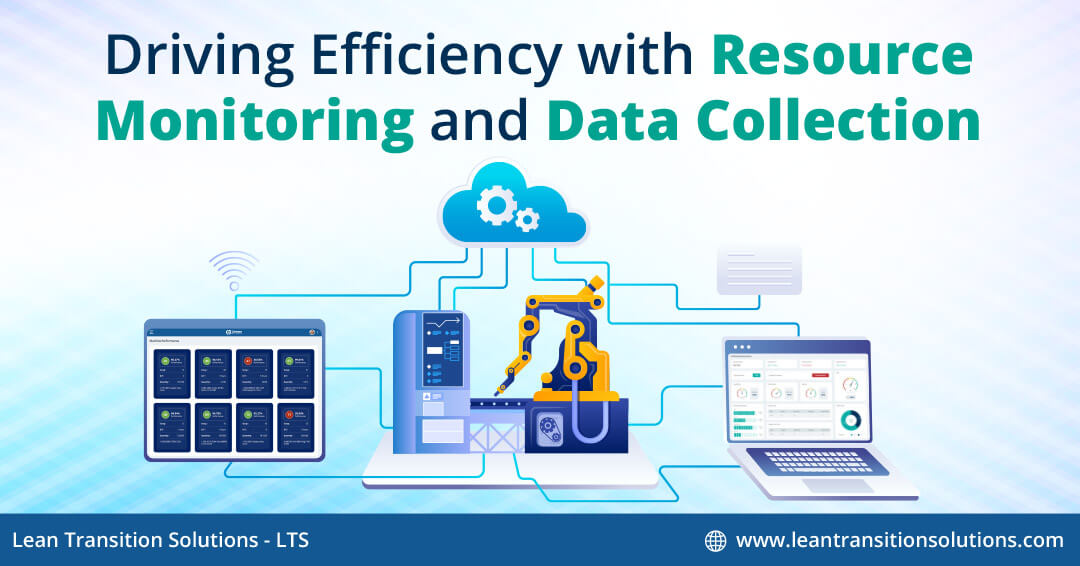Driving Efficiency with Resource Monitoring and Data Collection
January 17, 2024
In an era where every click, interaction, and transaction leaves a digital footprint, utilising the power of comprehensive data collection has become vital for companies that aim to succeed. Data collection provides valuable insights that drive informed decision-making, strategic planning, and competitive advantage for top companies. Let's understand the role of data collection and resource monitoring, exploring how it shapes the essence of modern business, paving the way for innovation, efficiency, and unparalleled growth.
What is Data Capture and How does it Benefit your business?
Data collection is a crucial process that involves gathering, analysing, and interpreting information. It plays a prominent role in the strategic evolution of businesses, providing them with actionable insights crucial for informed decision-making. Data collection stands as the top priority for many companies as it identifies patterns and trends in customer behaviours and preferences. This helps businesses to tailor their strategies accordingly. In today's data-driven world, data collection is crucial to optimise operational efficiency and marketing efforts, as it serves as a compass that guides businesses towards success. Leveraging sophisticated data collection software further enhances this process, streamlining data collection, analysis, and interpretation, enabling organisations to extract meaningful insights with greater speed and accuracy.
How can you Monitor Resources using Data Collection Software?
Monitoring resources using data collection software involves a systematic process that ensures comprehensive tracking and analysis. Here are the steps for effective resource data tracking and monitoring:
- Define Objectives and Key Metrics: Clearly outline the objectives of resource monitoring. Identify key metrics aligning with organisational goals, whether optimising efficiency, reducing downtime, or improving overall performance.
- Select Appropriate Data Collection Software: Choose a data collection software that suits the specific needs of your resource monitoring goals. Consider factors such as scalability, compatibility with existing systems, and the ability to capture real-time data.
- Integrate Data Sources: Integrate the software with relevant data sources. This may include sensors, IoT devices, databases, and other systems that generate data related to the monitored resources.
- Configure Monitoring Parameters: Define the parameters for resource monitoring. Set thresholds and alerts to trigger notifications when certain conditions are met or deviate from the norm. This proactive approach helps in identifying issues promptly.
- Real-Time Data Capture: Enable real-time data capture to ensure you have up-to-the-minute information on resource utilisation and performance. This allows for immediate responses to changing conditions or unexpected events.
- Data Aggregation and Analysis: Aggregate the collected data and employ analytical tools within the software to gain insights. Analyse patterns, trends, and anomalies to derive meaningful conclusions about resource usage and efficiency.
- Generate Reports and Dashboards: Utilise the reporting and dashboard features of the software to create visual representations of the monitored data. This makes it easier for stakeholders to grasp key information and trends at a glance.
- Continuous Monitoring and Feedback Loop: Implement a continuous monitoring strategy. Regularly review the data, update monitoring parameters as needed, and establish a feedback loop to ensure the ongoing relevance and effectiveness of the resource monitoring process.
Benefits of Resource Monitoring using Data Collection Software
- Enhanced Decision-Making: Resource monitoring through data collection software provides organisations with real-time insights, empowering informed decision-making based on accurate and up-to-date information.
- Optimised Operational Efficiency: Data collection software can enhance operational efficiency by automating resource data collection and minimising errors.
- Proactive Issue Identification: Continuous monitoring of resources allows for the early identification of potential issues or inefficiencies, enabling organisations to address them before they escalate, thus enhancing overall system reliability.
- Tailored Strategies: Data collection software helps businesses make informed decisions by identifying customer behaviours and preferences patterns.
- Cost Savings: Efficient resource allocation, reduced downtime, and optimised processes contribute to cost savings, making data collection software a valuable investment for long-term financial benefits.
- Compliance Assurance: Automated data collection ensures adherence to industry regulations and standards, providing a reliable mechanism for maintaining compliance and avoiding potential legal or regulatory issues.
- Improved Customer Satisfaction: By understanding and responding to customer behaviours, businesses can enhance the quality of their products and services, ultimately leading to increased customer satisfaction and loyalty.
- Strategic Planning: The insights from data collection software derived through resource monitoring contribute to effective strategic planning, enabling organisations to align their goals and objectives with market trends, resource planning and emerging opportunities.
The Road Ahead: Trends in Data Collection and Resource Monitoring
- AI and Machine Learning: Adopting artificial intelligence (AI) and machine learning algorithms for more sophisticated data analysis is rising. These technologies enable predictive analytics, anomaly detection, and automation of decision-making processes in resource monitoring.
- Edge Computing: With the growing need for real-time insights, edge computing is becoming increasingly prevalent. Applications for resource monitoring benefit from processing data closer to the source, which reduces latency and ensures quicker response times.
- Blockchain for Data Security: Blockchain technology is being explored to enhance the security and integrity of collected data. Its decentralised and tamper-resistant nature provides a robust framework for ensuring the authenticity of information in resource monitoring systems.
- Cloud-Based Solutions: The shift towards cloud-based solutions continues, offering scalability and flexibility in handling vast amounts of data. Cloud platforms facilitate seamless access, storage, and data analysis, making resource monitoring more agile and scalable.
- Focus on Sustainability: Resource monitoring aligns with sustainability goals, focusing on energy consumption, environmental impact, and overall resource efficiency. Businesses are leveraging data to optimise processes and reduce their ecological footprint.
- Customisation and Personalisation: Tailoring data collection strategies and resource monitoring approaches to specific business needs is gaining importance. Customised solutions allow organisations to extract more relevant insights and optimise resources based on their unique requirements.
Data capture software serves as intelligent gatekeepers, capturing, analysing, and interpreting data in real-time, thus presenting a comprehensive and accurate portrait of resource dynamics. Data capture software optimises operational workflows to ensure compliance with industry regulations.
The adaptability of data capture software becomes evident in its role as a catalyst for informed decision-making. By distilling complex datasets into actionable insights, these tools empower organisational leaders to make timely and strategic choices, ensuring a competitive edge in a rapidly evolving market.
As we bid farewell to traditional approaches and welcome the era of intelligent resource management, it becomes evident that the judicious integration of data capture software is the cornerstone for businesses aiming to survive and thrive, adapt, and lead in the digital age.
